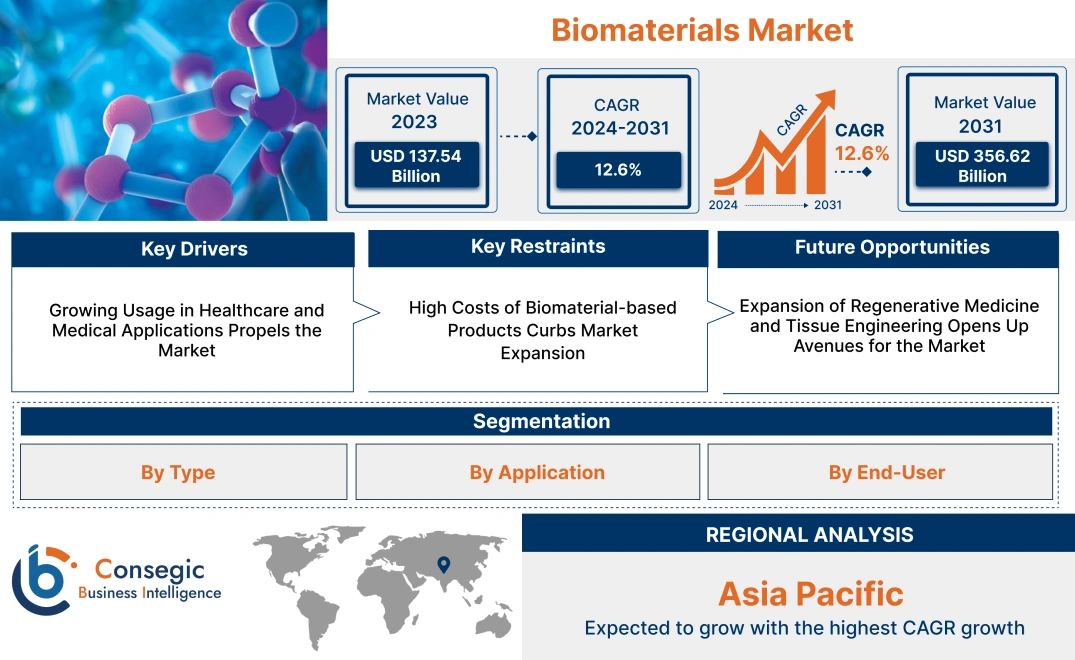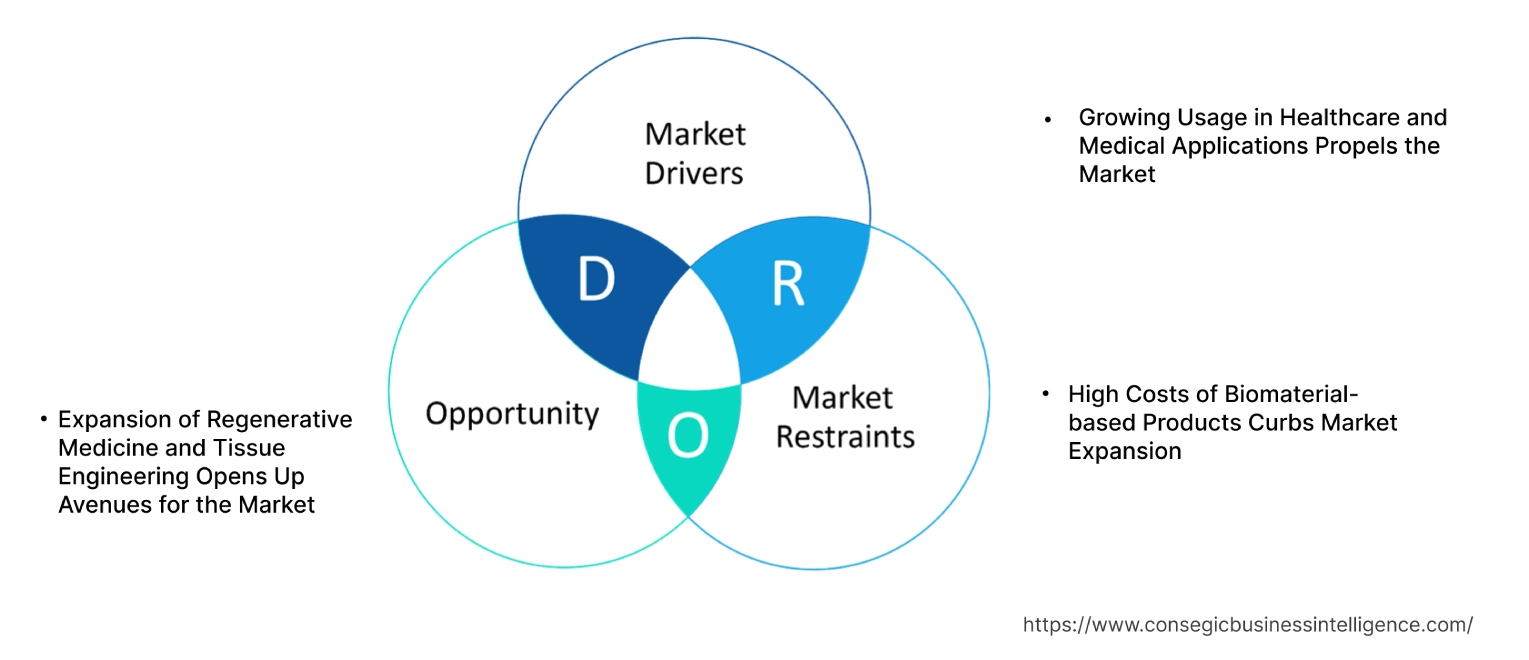- Summary
- Table Of Content
- Methodology
Biomaterials Market Size:
Biomaterials Market size is estimated to reach over USD 356.62 Billion by 2031 from a value of USD 137.54 Billion in 2023 and is projected to grow by USD 152.49 Billion in 2024, growing at a CAGR of 12.6% from 2024 to 2031.
Biomaterials Market Scope & Overview:
Biomaterials are those synthetic or natural substances that are engineered to interface with biological systems. It is especially helpful for therapeutic and diagnostic purposes. They are capable of replacing various tissues within the body, even organs. Their chief property is that they are highly biocompatible, meaning they do not necessitate an immune response from the body. It has other useful properties such as high mechanical strength, longer durability, and is non-toxic, making them biodegradable. It also has impressive hydrophilicity, structural roughness, and tunable chemical composition that dictates it will react with tissues and cells. The benefit of using these materials in inpatient treatments is that they accelerate healing, especially for joint surgery, orthopedic implants, or prosthetics. The treatments that incorporate these materials are minimally invasive and can be essential in targeted drug delivery. Thus, these materials could be used in the healthcare and medical sectors, the cosmetic sector, biotech, etc.
Biomaterials Market Insights:
Key Drivers:
Growing Usage in Healthcare and Medical Applications Propels the Market
Biomaterials are increasingly being used in joint implants, dental surgeries, cardiovascular devices, etc. The aging demographic who are easily prone to osteoporosis, heart problems, dental issues, etc. require biomaterial-based medical devices. They are also helpful in targeted drug delivery, and as such can help in managing chronic conditions like diabetes. The advancement of biotechnology has engineered more competent materials that have better biocompatibility, strength, etc. They are also used in scaffolding for tissue regeneration, making them important in repairing or replacing damaged tissues.
- Chitosan, a biopolymer which is derived from chitin, has been an emerging biomaterial that can be employed in wound healing. It is biodegradable, biocompatible, and has an affinity to biomolecules. This natural biomaterial has exceptional restoring capabilities that accelerate the generation of new skin cells, reduce inflammation, and help in the prevention of infections. Chitosan-based materials are effective in healing chronic wounds like liver ailments or diabetic ulcers as well as antibacterial dressings.
Therefore, as these materials are highly sustainable, it leads to increased usage, contributing to biomaterials market growth.
Key Restraints :
High Costs of Biomaterial-based Products Curbs Market Expansion
Certain biomaterials, especially advanced ones, like biodegradable polymers, ceramics, etc. are made up of high-cost raw materials. The production of these materials can often be complex making it expensive. For example, the equipment in tissue engineering requires cutting-edge expertise, which hikes up the production costs. The strict regulatory restrictions placed on implementation directly demand high-quality production to ensure proper biocompatibility. This ends up surging the production costs, making biomaterial-based products expensive.
- An article published in Forbes in December 2023, highlights the ways the high cost of biomaterials affects the automotive industry. The primary stage of production includes natural sourcing while the second stage includes genetic modification of heterotrophic organisms and the third is to employ autotrophic organisms. This results in heightened feedstock expenses.
Therefore, high-cost production often discourages companies from investing in these materials, leading to stunted biomaterials market demand.
Future Opportunities :
Expansion of Regenerative Medicine and Tissue Engineering Opens Up Avenues for the Market
In tissue engineering, biomaterials are essential in scaffolding. This provides the cells with a framework that accelerates tissue regeneration. They often duplicate the original extracellular matrix that supports the reformation of bone cartilage, tissues, skin, etc. Since these materials have excellent biocompatibility, they can be safely integrated into the human body and encourage tissue development. They are also used in regenerative medicine production which focuses on helping the body to repair itself. These regenerative medicines can also be engineered to be personalized to each patient, resulting in more effective treatment outcomes.
This fusion improves the efficiency of industries including healthcare, manufacturing, and energy.
- In 2024, researchers made exceptional improvements in tissue engineering technology by integrating biomaterials to offer a new strategy for spinal cord injury (SCI) treatment. The aim is to combine representative biomaterials such as synthetic, hybrid, and nanomaterials to fabricate methods for tissue restoration.
Thus, as stem cell research propels regenerative medicines and tissue engineering, the need for biomaterial-based artificial organs and tissue substitutes grows. This drives the biomaterials market opportunities.
Biomaterials Market Segmental Analysis :
By Type:
The market is segmented based on type into Metallic, Polymeric, Ceramic, Natural, Composite, and others.
Trends in the Type:
- In recent years, the adoption of biocomposites in medical care has been gaining traction due to their enzyme-responsive structures for efficient drug delivery.
- Polymeric biomaterials such as polyethylene are trending owing to their unique physio-chemical properties.
Metallic biomaterials accounted for the largest revenue share of 35.40% in the biomaterials market share in 2023.
- Metallic biomaterials have high mechanical strength, allowing them to handle bodily wear and tear resulting in long-term durability. This renders them suitable for orthopedic transplants and dental implants.
- The advancement made in biotechnology has given these materials the properties of anti-corrosion, osseointegration, and high bioactivity. This increases their efficiency in medical procedures.
- For instance, in 2022 a group of researchers developed a cobalt-based alloy as a biomaterial for enhancing bone strength during implants by providing premier support. It duplicates the flexible nature of human bones and has high resistance.
- Thus, as per the biomaterials market analysis, metallic biomaterials tend to be cost-effective too, making them widely available for use in various applications, driving the biomaterials market growth.
Polymeric biomaterials are expected to have the fastest CAGR for the forecasted period.
- Polymeric biomaterials are highly versatile and as such can be easily personalized to meet specific needs in medical care.
- They are biodegradable and can be naturally broken down within the body. This is helpful for temporary scaffolding, tissue regeneration, responsive drug delivery, etc.
- They have efficient production costs, making them attractive to both manufacturers and patients.
- They are highly flexible and are minimally invasive. This makes them an ideal implantation material for the body as it lessens bodily discomfort.
- For instance, Sumitomo Rubber Industries partnered with Kyushu University in 2024 and announced an Endowed Research Department for developing and advancing the production of high-performance biopolymers. The aim is to regulate the adhesive properties of particular cells and interpret interactions between cells, proteins, and polymers. They would leverage state-of-the-art nano-bio plane surveys.
- Therefore, as the trend of shifting towards these materials rises, this segment experiences fast progress, in turn driving the biomaterials market trends.
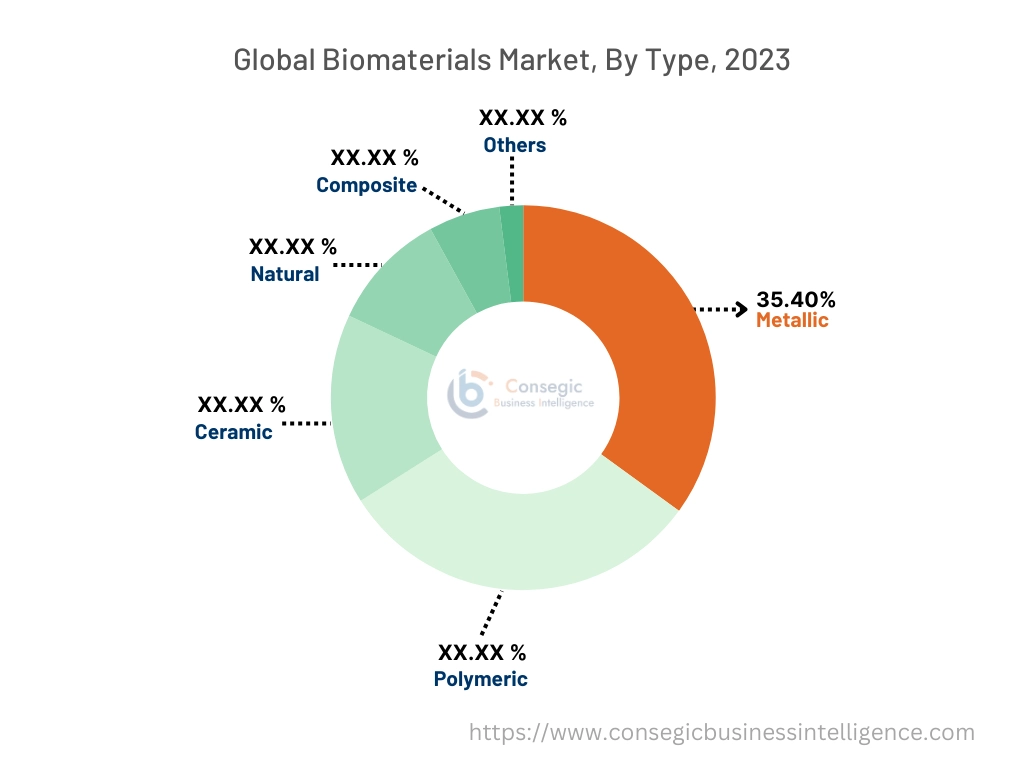
By Application:
The market is segmented, based on application, into cardiovascular, orthopedic, dental, plastic surgery, ophthalmology, wound healing, tissue engineering, neurology, drug delivery, and others.
Trends in the Application:
- Researchers are developing bioactive molecules for scaffolding in implants for neurological care, dental care, wound healing, etc.
- In a recent trend, there is a high demand for injectable hydrogels for organ-on-chip (OOC) devices made from biomaterials in tissue regeneration.
Orthopedics accounted for the largest revenue share in 2023.
- The aging demographic relies on orthopedic implants such as knee or hip replacements as they are prone to musculoskeletal disorders.
- Biomaterials are effective in orthopedics as they can easily support bones and joints due to their superior mechanical strength.
- The growing number of sport-related injuries has driven the need for orthopedic surgeries, resulting in the growing requirement for these materials in transplants.
- They are biodegradable and result in a reduction of follow-up surgeries after orthopedic implants leading to better and durable recovery rates.
- Thus, as per the analysis, orthopedics due to its effective bone grafting resulted in the effective reconstruction of cartilage and tissues within the body, driving the biomaterials market demand.
Plastic Surgery is expected to have the fastest CAGR for the forecasted period.
- The popularity of cosmetic surgeries has raised the demand for the integration of biomaterials like polymer or silicone in plastic surgeries.
- Plastic surgeries are reconstructive in nature, and as such, heavily rely on these materials for tissue regeneration and new cell growth.
- The enhancement within the production of these materials has led to the development of bioengineered skin grafts, scaffolds, tissue fillers, etc. These are essential components of plastic surgery.
- They are highly biocompatible which makes them safe for integrating with skin cells without the risk of adverse reactions.
- For instance, in February 2024, a group of researchers from IOCB Prague and Ghent University developed a gelatin-based biomaterial for reconstructive and plastic surgeries. A paper was published in ACS Applied Engineering Materials where they highlighted the innovative ways 3D printed biomaterials are monitored using imaging techniques (CT scans, X-rays) to advance the possibilities in the medical field. As gelatin is known to be biodegradable, cost-effective, and non-toxic, it is suitable for the promotion of cell growth which aids in plastic surgeries.
- Therefore, as per the analysis, plastic surgeries will experience fast progress in the future due to biomaterials long-term durability and sustainability, boosting the biomaterials market opportunities.
By End-User:
The market is segmented based on end-users into Hospitals and Clinics, Academic & Research Institutes, Ambulatory Surgical Centers (ASCs), Biopharmaceutical Companies, and others.
Trends in the End-User:
- In a recent trend, the growth of biodegradable food is becoming a larger end-user industry for biomaterials as consumers shift to sustainable food choices.
- Academic & Research institutes have recently focused on developing which are lightweight but strong for efficient prosthetics.
Hospitals and Clinics accounted for the largest revenue in the biomaterials market share in 2023.
- Hospitals and Clinics form the primary sector of biomaterial integration as they offer a wide range of surgeries, cardiovascular stents, implants, etc.
- They have easy access to high-tech equipment and medical infrastructure, resulting in the adoption of enhanced biomaterial-based devices.
- Hospitals and clinics are primed to purchase biomaterials in expansive quantities owing to their high patient volume and diversified range of treatment offers.
- Hospitals and clinics have highly skilled medical forces, such as doctors, specialists, and researchers, who have the ideal knowledge of using these materials in therapies.
- For instance, Massachusetts General Hospital (USA), collaborates with the University of Memphis in its biomaterials research to analyze and study the microscopic procedures that bring about changes in material properties.
- Therefore, the government and insurers encourage biomaterial-based transplants and implants in hospitals and clinics. This results in the segment's contribution as the largest revenue-generating sector in this market.
Ambulatory Surgical Centers (ASCs) are expected to have the fastest CAGR for the forecasted period.
- Ambulatory surgical centers (ASCs) specialize in outpatient care. They offer day-in-day-out surgical procedures, and biomaterial-based medical care provides efficient, cost-effective, and safe transplants, implants, etc.
- ASCs rely on enhanced biomaterials such as polymer-based implants, absorbable sutures, etc. for minimally invasive surgeries.
- The rise in elective procedures such as liposuction, breast augmentation, and other cosmetic surgeries has created a demand for these materials in ASCs.
- ASCs are more convenient and approachable and offer patients with regenerative medicines for effective healing, leading to their growth.
- Thus, the analysis shows that ASCs experience fast growth due to the shift of patient preference from inpatient to outpatient medical care.
Biomaterials Market Regional Analysis:
The regions covered are North America, Europe, Asia Pacific, the Middle East and Africa, and Latin America.
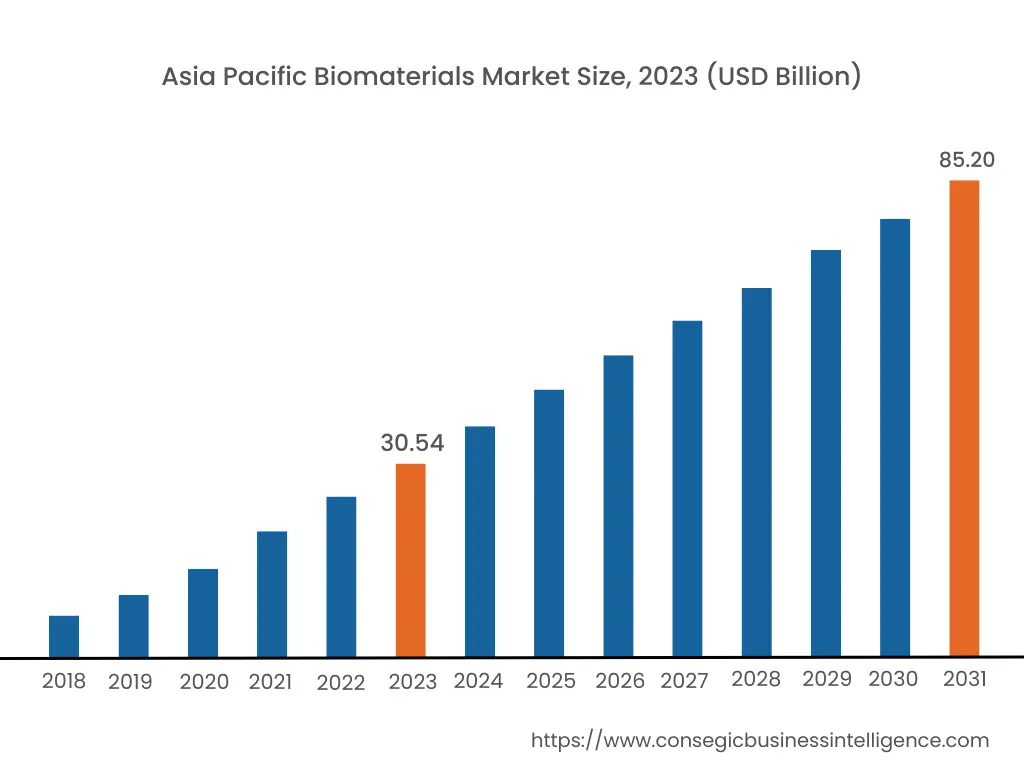
Asia Pacific region was valued at USD 30.54 Billion in 2023. Moreover, it is projected to grow by USD 34.07 Billion in 2024 and reach over USD 85.20 Billion by 2031. Out of this, China accounted for the maximum revenue share of 39.3%.
As per the biomaterials market analysis, the Asia Pacific region, especially countries like Thailand, Malaysia, South Korea, Japan, etc. are famous for medical tourism. They offer cost-effective healthcare and attract international patients for orthopedic and dental implants. This leads to the growth of biomaterial utilization in these nations and a widespread market for regenerative medicine.
- In December 2022, Jellagen, a medical biotech startup, received funds from Thai Union Group PCL through their Corporate Venture Capital (CVC) Fund. The funding of £8.7 million was aimed at revamping regenerative medicine production by leveraging varied medical devices and cultural applications such as medical tourism.
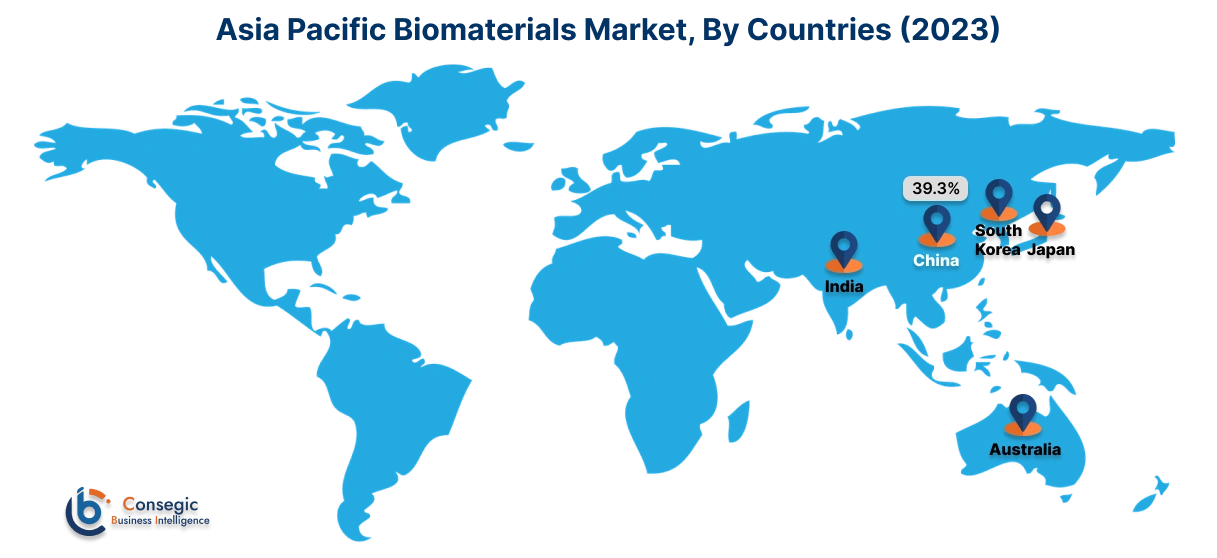
North America is estimated to reach over USD 134.37 Billion by 2031 from a value of USD 51.03 Billion in 2023 and is projected to grow by USD 56.65 Billion in 2024.
In North America, especially in the US and Canada, there is an advanced medical infrastructural base. This resulted in a heightened demand for biomaterials in medical care for applications such as tissue engineering, prosthetics, implants, etc. The government itself takes active initiatives to encourage improvement in the healthcare systems through incentives and grants. They heavily invest in research & development (R&D) for biotechnology which opens up new avenues in medical science.
- For instance, the first store digital twin offers new innovations in biopolymer's pharmaceutical and medical care applications. Their biopolymers are effective in tissue engineering and can duplicate any automated workflow.
The biomaterials market trends show that Europe is home to a larger proportion of the aging demographic who experience chronic illnesses, especially in Germany, Spain, Italy, etc. This results in a high need for these materials in the region as the need for cardiovascular devices, dental implants, etc. is omnipresent.
The Middle East and Africa (MEA), especially the Gulf region, has been experiencing rapid industrialization and urbanization. The government insists on lowering the reliance on medical imports. This has surged their production of local manufacturing of medical devices, raising the requirement for these materials in this region.
The regional analysis depicts that in Latin America, especially in nations such as Mexico, Costa Rica, etc., there is a prevalent cardiovascular disease culture such as heart attacks, strokes, etc. This has driven the need for these materials in cardiology in these regions. This, in turn, boosts the biomaterials market expansion.
Top Key Players & Market Share Insights:
The biomaterials market is highly competitive with major players providing products and services to the national and international markets. Key players are adopting several strategies in research and development (R&D), product innovation, and end-user launches to hold a strong position in the global biomaterials market. Key players in the biomaterials industry include:
- BASF (Germany)
- Corbion N.V. (Netherlands)
- Covestro AG (Germany)
- Medtronic (Ireland)
- DSM (Netherlands)
- Evonik Industries AG (Germany)
- Zimmer Biomet (USA)
- Stryker (USA)
- CRS Holdings, LLC (USA)
- Berkeley Advanced Biomaterials (USA)
Recent Industry Developments :
Product Launches:
- In June 2023, IFF announced the launch of Designed Enzymatic Biomaterials (DEB) technology. It aimed at raising the scalability of developing bio-based materials. These are engineered to be environmentally sustainable to meet the needs of eco-friendly biopolymers.
- In January 2024, CJ Biomaterials, a South Korean company, announced the launch of a new biobased PHA technology food product. This new cup noodle product is coated with biodegradable and compostable PHA. They aim to reduce plastic waste entering the environment through their patented PHA technology.
Mergers & Acquisitions:
- In July 2024, Repligen Corporation announced its intention to acquire Tantti Laboratory Inc. Repligen is a bioprocessing life science company, whereas, Tantti is a biomaterial engineering firm. The latter has developed rare chromatography beads, Tantti's DuloCore, to enhance the purification of modalities like nuclei acids. This acquisition deal allowed Repligen to break even on adjusted profit margins and earnings per share (EPS) for the upcoming two years.
Partnerships & Collaborations:
- In May 2024, a biotech firm, BIO INX announced the launch of a new volumetric 3D printing technology in collaboration with Readily 3D. This new commercially available bio-ink, READYGEL INX, is a gel-MA-based ink that has been engineered for high replicability and enhanced performance for bioprinting.
Biomaterials Market Report Insights :
| Report Attributes | Report Details |
| Study Timeline | 2018-2031 |
| Market Size in 2031 | USD 356.62 Billion |
| CAGR (2024-2031) | 12.6% |
| By Type |
|
| By Application |
|
| By End-User |
|
| By Region |
|
| Key Players |
|
| North America | U.S. Canada Mexico |
| Europe | U.K. Germany France Spain Italy Russia Benelux Rest of Europe |
| APAC | China South Korea Japan India Australia ASEAN Rest of Asia-Pacific |
| Middle East and Africa | GCC Turkey South Africa Rest of MEA |
| LATAM | Brazil Argentina Chile Rest of LATAM |
| Report Coverage |
|
Key Questions Answered in the Report
How big is the biomaterials market? +
Biomaterials Market size is estimated to reach over USD 356.62 Billion by 2031 from a value of USD 137.54 Billion in 2023 and is projected to grow by USD 152.49 Billion in 2024, growing at a CAGR of 12.6% from 2024 to 2031.
What specific segmentation details are covered in the biomaterials market report? +
The biomaterials market is segmented into type, application, and end-user industry.
Which is the fastest-growing region in the biomaterials market? +
Asia Pacific is the fastest-growing region in the biomaterials market.
Who are the major players in the biomaterials market? +
The major players in the market include BASF (Germany), Corbion N.V. (Netherlands), Covestro AG (Germany), Evonik Industries AG (Germany), Zimmer Biomet (USA), Medtronic (Ireland), DSM (Netherlands), Stryker (USA), CRS Holdings, LLC (USA), and Berkeley Advanced Biomaterials (USA).
